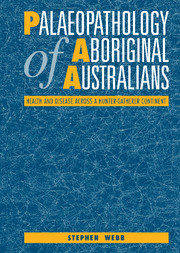Book contents
- Frontmatter
- Contents
- List of illustrations
- List of tables
- Acknowledgements
- 1 Introduction
- 2 Australian palaeopathology, survey methods, samples and ethnohistoric sources
- 3 Upper Pleistocene pathology of Sunda and Sahul: some possibilities
- 4 Pathology in late Pleistocene and early Holocene Australian hominids
- 5 Stress
- 6 Infectious disease
- 7 Osteoarthritis
- 8 Trauma
- 9 Neoplastic disease
- 10 Congenital malformations
- 11 Motupore: the palaeopathology of a prehistoric New Guinea island community
- 12 The old and the new: Australia's changing patterns of health
- References
- Index
6 - Infectious disease
Published online by Cambridge University Press: 21 May 2010
- Frontmatter
- Contents
- List of illustrations
- List of tables
- Acknowledgements
- 1 Introduction
- 2 Australian palaeopathology, survey methods, samples and ethnohistoric sources
- 3 Upper Pleistocene pathology of Sunda and Sahul: some possibilities
- 4 Pathology in late Pleistocene and early Holocene Australian hominids
- 5 Stress
- 6 Infectious disease
- 7 Osteoarthritis
- 8 Trauma
- 9 Neoplastic disease
- 10 Congenital malformations
- 11 Motupore: the palaeopathology of a prehistoric New Guinea island community
- 12 The old and the new: Australia's changing patterns of health
- References
- Index
Summary
General introduction
In one sense this chapter is a continuation of the previous one. There I described indirect indicators of stress but I also alluded to a contributor to them: infectious disease. This chapter describes the evidence for infection as it appears on the skeletal remains of Australian Aborigines. To do this I have divided bone infection into two types: non-specific and treponemal. My definition of non-specific infection uses three different pathological conditions: periostitis, osteitis and osteomyelitis. The treponemal section discusses the evidence for this condition as it appears on the cranium only and uses well known morphological criteria to describe lesions of this type. At the end of the chapter I discuss tibial bowing. I have included it because it has often been observed among Aboriginal people living in northern and arid areas of the continent who, at the same time, are suffering from a form of treponematosis endemic to those parts of Australia. The apparent association between treponemal disease and bowing, suggested by some, makes its inclusion here important (Hackett 1936a,b; Jaffe 1975; Steinbock 1976).
Non-specific infection
Introduction
Infection of the bone has probably occurred ever since it was possible for bacteria and bone to come together. Evidence for it goes back a long way, all the way, in fact, to its appearance in Permian dinosaur remains (Moodie 1923). Bone infection among humans is, and probably always has been, universal.
- Type
- Chapter
- Information
- Palaeopathology of Aboriginal AustraliansHealth and Disease across a Hunter-Gatherer Continent, pp. 125 - 160Publisher: Cambridge University PressPrint publication year: 1995



